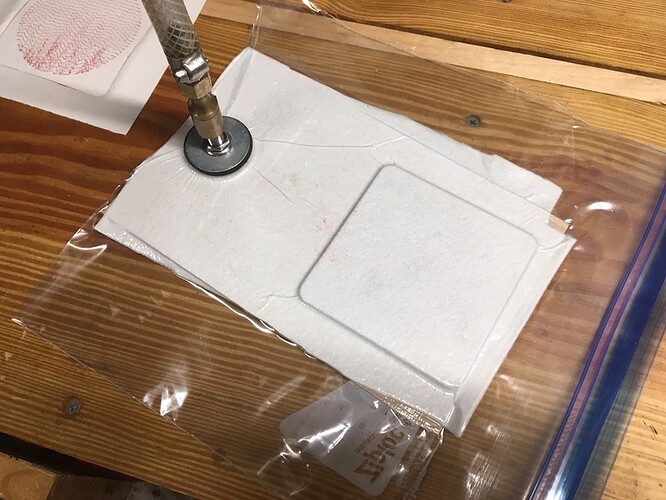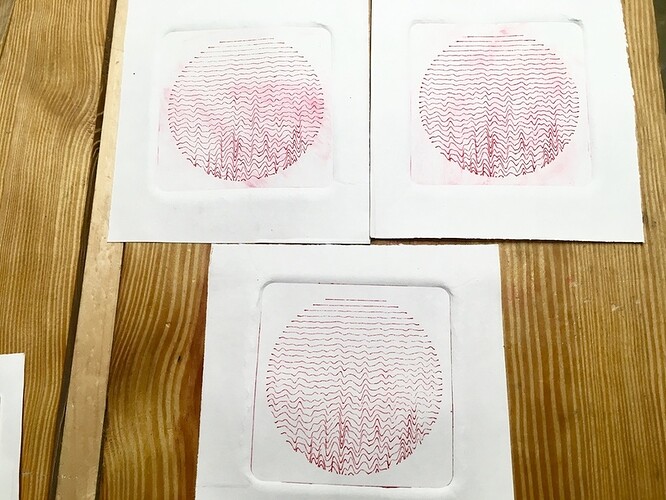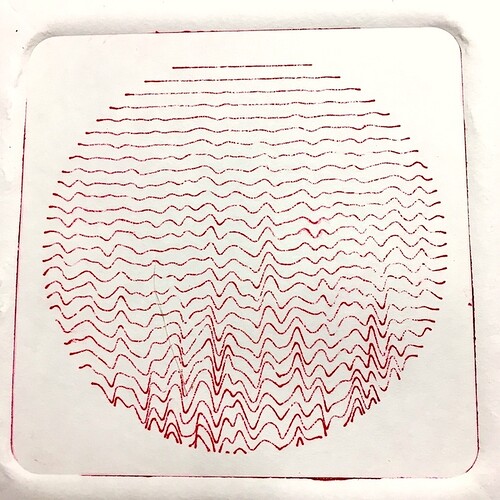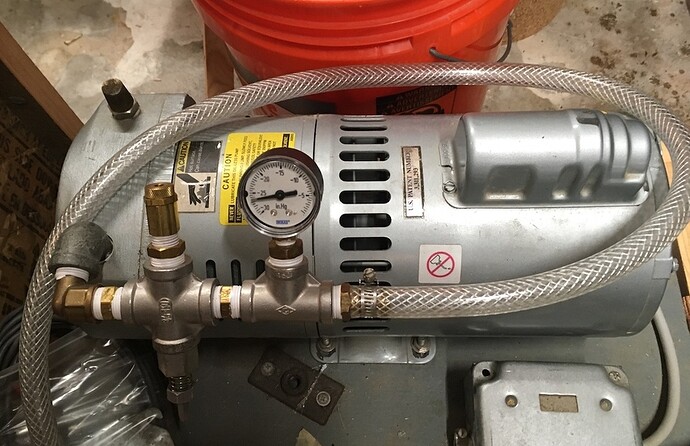How about ! ! . . . . . . . . . . . .
! . . . . . . . . . . . .
Put the printing ‘sandwich’ in a modified zip-lock bag, suck all the air out with a shopvac, and you’ve got vacintaglio printing ?
What a great and hilarious walk-through to a try at printmaking. Loved the story.
Only gets 30psi or so while a ton of car will get you 55 psi on a 6x6 square and 125 psi on a 4x4 square. I would want 300psi is my guess and that you might get with a mechanical press, or better yet just use the car’s jack in the front of the biggest car (or truck) you can find
Anyone know someone with a tank?? ![]()

I assume you mean texture down in the score grooves, and the answer is yes! It seemed to have enough tooth to hold the ink. Here’s a picture of my test small plate, the real thing was too hard to photograph because I engraved both sides of it.
I tried several different engraving depths. If I went too shallow, obviously it didn’t hold the ink. If I went too deep, however, it seemed like the paper never quite got forced down into the grooves deep enough, which gave me a really interesting speckled look, but not what I was going for. I think using the right paper and soaking it for the proper amount of time would help there.
The acrylic survived being run over just fine. I am not the first person to do intaglio printing with an acrylic plate, drypoint etching on acrylic/plexiglass is a real thing, where folks use a sharp metal or diamond tool to scratch the surface of an acrylic plate. Generally speaking those plates are not considered to hold up as well as the acid-etched metal, but I don’t know if that’s something inherent to the acrylic or to the dry-point process itself (which I’m guessing will not scratch as deep as an acid will etch?). I pulled about two-dozen prints last night and it seems to have held up well.
In fact the Akua brand of intaglio inks are both water-based and specifically say they are compatible with plastic plates, sadly the art store was all out of them so I used an oil-based block printing ink. But I plan on giving the Akua ones a spin!
Regarding acrylic vs delrin, I haven’t the faintest clue, but I suspect the hardness of the material might have a lot to do with how it prints. Real etchings are done on copper, which is a soft metal. Perhaps that softness is an advantage that allows the plate to deform slightly under pressure and squeeze the ink out of the grooves?
Another thing I will try using the correct paper. Real intaglio printers soak their paper for a good 5 minutes or longer, to get the fibers nice and fluffy before it is smashed into the plate.
Totally agree with you both on this one. I like seeing the laser cutter used as a component of the process, but not the end itself. I didn’t mention it in my original post, but the artwork that I printed is from a generative algorithm that I wrote. The magic for me is the dichotomy of programming a computer to make a design, then producing a finished piece using with a wonderful organic plate-tone in the background of the vector art—the joy for me is the transformation of materials through the process. When framed in those terms, your printmaking prof would probably dig it. ![]() And also making experimental art by running things over with a truck, with little clue what you’re doing, is just plain fun.
And also making experimental art by running things over with a truck, with little clue what you’re doing, is just plain fun.
a 50-ton jack on the inside pressing against the ceiling. or even just lifting up one side with a jack would do better. Like snow shoes the whole point of having treads is to spread the weight out so the psi at any point under the treads is quite low compared to the weight of the tank. A friend of mine had a swamp buggy with treads like that and he could run across your hand without hurting it, (or across soft mud without sinking in)
Hats off to @johnbrooker and @rbtdanforth for suggesting the vacuum bag idea! I happen to have a hardcore vacuum pump and vacuum bagging equipment for doing fiberglass and carbon fiber surfboards. In my haste last night it didn’t even occur to me to try using it as a press. Well I popped the plate and paper into a ziplock bag with some fleece, and pulled the best prints of the run!!
Despite atmospheric pressure only being about 14psi (or 30" of mercury), and my particular pump only pulling 27"hg tonight (13psi, and about the max you’re realistically ever going to pull in your garage and not a physics lab) this worked amazing and pulled better prints than the car press. Also MUCH more convenient! I suspect the print quality has something to do with the vacuum bag being flexible, so the bag itself can flex down into the etching lines… not much, not noticeable, but, uh, theoretically anyways, it is giving perfectly even pressure across the entire plate. (Exactly why people use them for composites, boatbuilding, and wood veneering.)
Thanks for the proof of concept @rschenk, great pics !
By the way, if you were trying to describe the bag set up, what do you call that adapter that joins the tube to the bag ?
I was going to add that to my original suggestion, but had no idea what to call it !
I’ve used the same set up when laminating a gull-wing shaped sound board for my hammer dulcimer from1/16 plywood over a carved pu foam former. Worked a treat.
And yes, I also think that the key difference is that the flexible felt and damp paper actually get pulled into the engraved lines, so picking up more ink, and much more uniformly.
I suspect it will produce much less wear on the plate, so should be good for much longer runs. In fact I don’t see any wear occurring, so I’ve no idea what the limit might be !

I think the technical term in the composites world is simply vacuum bag connector, or bag stem, or bag port… I don’t think there’s a special word for it!
Stoked to hear about your vacuum bent lamination. I do similar stuff with wood surfboards. If you search this forum for my one other post, “hydrofoil board”, I did a bit of vacuum lamination on that project, nothing too complex.
Quick update for future readers, I got some actual intaglio ink and some good quality paper. Really stoked with the prints now! Turns out, if you use the right supplies, your project comes out well! I soaked the paper about 30 seconds in water, blotted it dryish, and printed with my vacuum ziplock bag press.
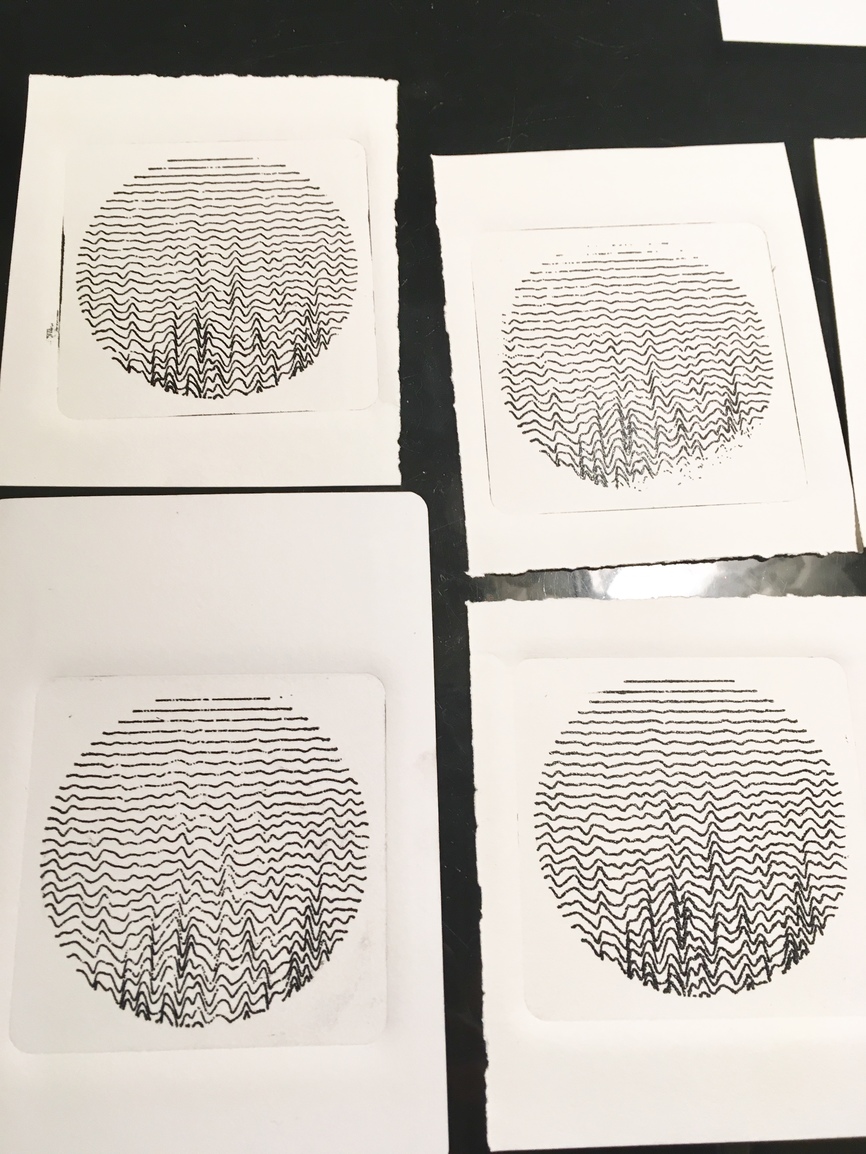
The deckle edge on the paper suggests to me that it is more than just good quality paper !
Is that something like a soft rag paper ?
Not my current field, but (and please don’t tell SWMBO this) I might just drift over to playing with printing methods, given the versatility of GF.
I can always justify it as fan leaf research. 

And are you soaking the paper at all? Getting good transfer from an etched plate involves floating the high quality paper (Reeves BFK?) in water, doing the pressing, and then taping it to a drying board to flatten it as it dries, and to prevent skewing during the drying/shrinking…
Er . . .should this question be directed at the OP ?
I’m not doing any etching , only conducting thought experiments !
I am familiar with the way most papers behave when wetted though.
I have successfully laminated 18" x 30" sheets of tissue paper using starch paste, and laying that up without any air trapped between the sheets was fun, as you might imagine.
Made a good base for fan leaf painting though. I stretched them over wooden frames with a removable centre block, so they dried drum tight, and my wife could paint on both sides of the leaf.
Ah, reminiscences of a fan maker’s life !

Funny, right… Whodathunkit?
Yes, sorry! I should have located the most recent comment on the thread by the OP… and I should correct the word “etch” to be “engrave” or “engraving,” which is more accurate to the state of the plate here.
I would think that the vacuum may also gentle pull the ink out of the grooves towards the material?
Also, this was my favorite part: Congratulations you have made an art!
That’s a very interesting idea.
It would happen, if there was air trapped underneath the ink in the grooves. small bubbles of air would expand, and possibly push the ink up onto the paper, as well as the paper being pulled down.
I guess a small effect, but would contribute to the print.
It’s more likely that the air would get pulled out of the ‘lines’ through any gaps in the inking, but who knows !

i ntaglio needs 350wt. paper and soaked a minimum of 20 minutes.
when you don’t have a really fluffy friend you use the car is my guess.

